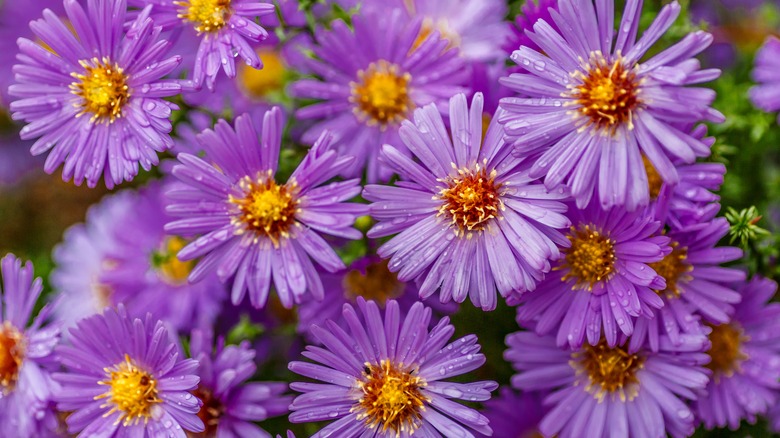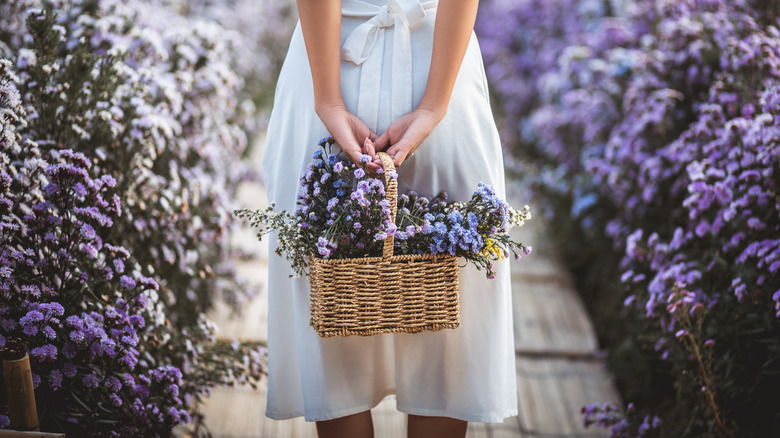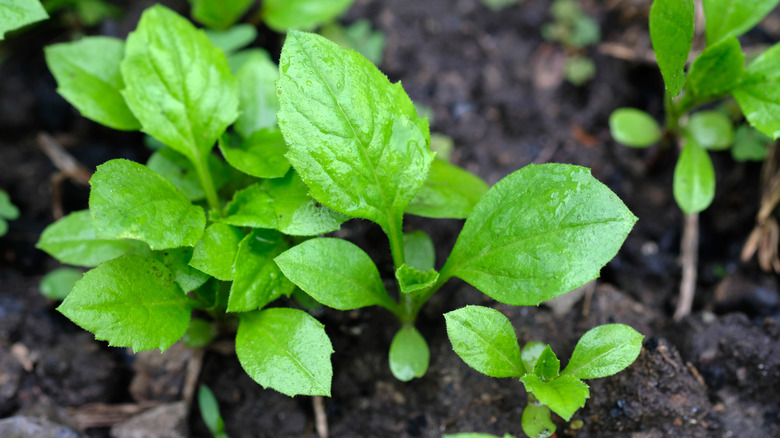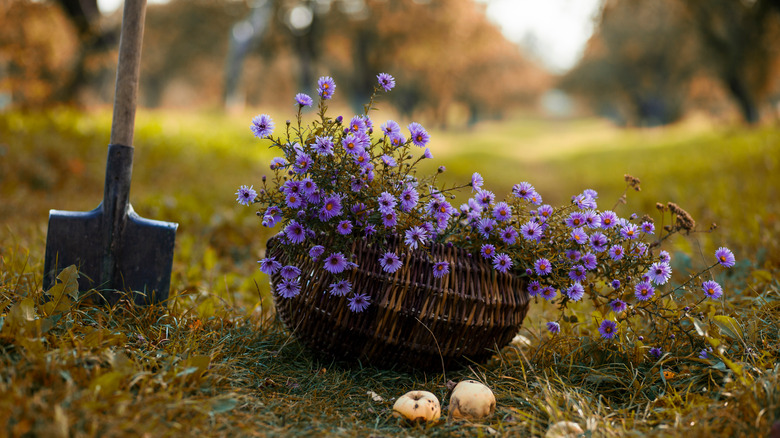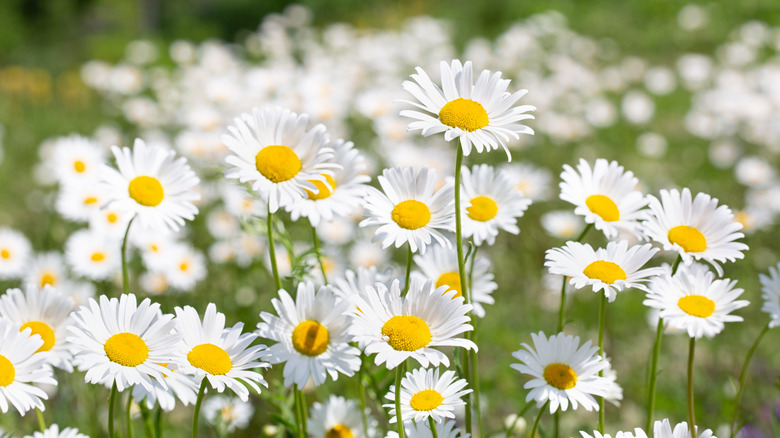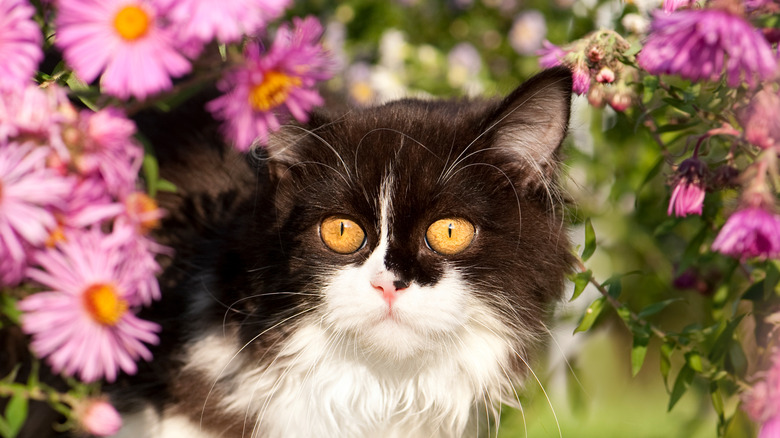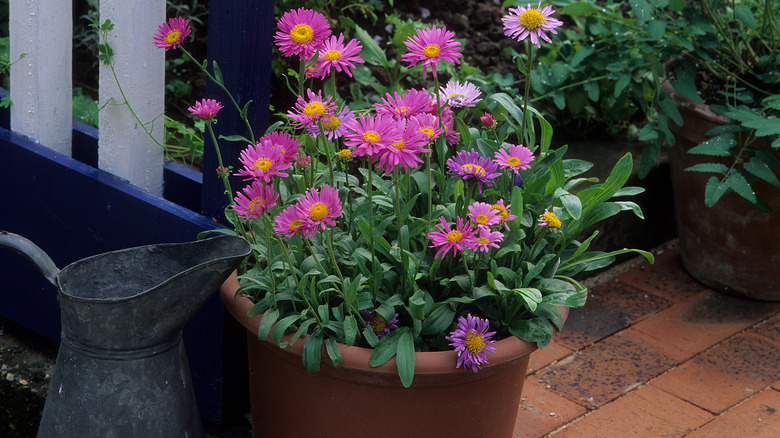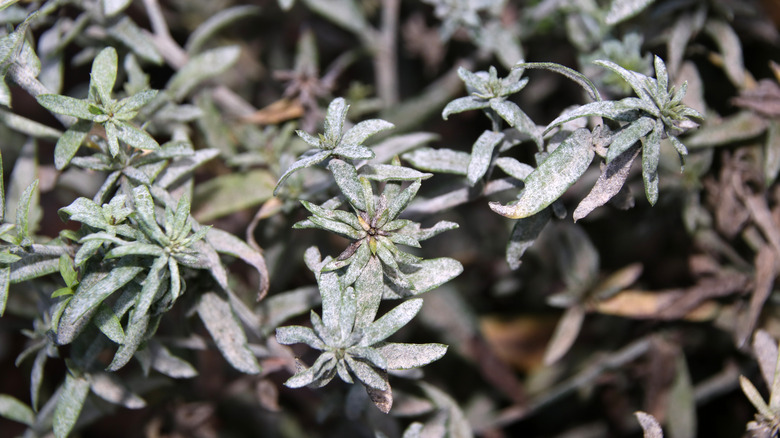How To Grow And Take Care Of Asters
Asters are a perennial flowering plant that make up part of the Asteraceae family. Their name comes from the Greek word for star, which is fitting given their star-shaped blooms that feature multiple skinny petals shooting out from around a center point, as per Better Homes & Gardens. The blooms share similarities in size and appearance with daisies and come in a variety of colors, including purple, pink, white, and blue. The aster plant varies a bit in size, ranging from 1 to 6 feet in height and 1 to 4 feet in width, depending on the species. Its foliage stays green throughout the entire year, even after the flowers pass through their growing season, which starts in spring and extends into the fall.
This plant offers more than just beautiful blooms to brighten up your outdoor space. According to Currans Flowers, asters also hold plenty of symbolic and historic significance. Asters are said to symbolize many virtues, including love, faith, wisdom, and even good luck. In some ancient traditions, people would also burn the aster foliage as a way of warding off evil spirits. Additionally, the flower is said to be able to predict future weather developments in that the petals close before rain strikes. If you choose asters for your garden, you'll find that they are easy to grow. Check out the following guide for everything you need to know about growing and caring for asters.
How to use asters in garden
Asters work well in most outdoor spaces and gardens in a variety of locations due to their wide range of sizes and colors. The best part about this flowering plant is that it continues to bloom late in the season, well past the bloom times of many other members of your garden, making it a great option for planting among flowers with shorter bloom times, shares Garden Design. Asters grow well in large batches, allowing you to fill entire beds while interspersing other plants in between. In this same respect, they can also be used to create borders within your yard, whether that be along fences or walls, or simply as a natural enclosure around other plant species.
When it comes to companion plants, you'll want to choose ornamental grasses or other plants that consist mostly of foliage in order to enhance the colors of your asters. Gardenia suggests the Japanese Anemone for a companion flowering plant as it also provides blooms into the fall season. Achilleas, Helenium, and Chrysanthemums are other plants that grow late in the season and will complement your asters well. You can also consider planting asters amid a variety of plants with differing heights to emphasize the aster blooms once the rest of the flowers have died off. For smaller yards or patios and decks, asters grow well in containers and pots, which also gives you the opportunity to move them around throughout the year.
How to grow asters
Asters can be planted as seeds or from a potted plant purchased from your local nursery, as per Almanac. While the choice is yours to make, purchasing asters that have already become young plants is much easier than growing them from seeds. If you do choose to go the seed route, there are a few extra steps you will need to take. To get started, you will need to have growing pots and potting soil on hand. When winter comes, plant one seed in each pot and then store them in a refrigerator for about a month to a month and a half while they germinate. Following this period, you can place the pots next to a sunny window where they will become seedlings. By the time spring arrives, you should be able to plant them in your garden.
Planting both germinated plants and plants purchased from the nursery requires the same steps. You will need to dig holes in your garden that are spaced between 1 and 3 feet apart. Your asters will need more space if they are of a larger variety. The next step is to place the young plant in the hole and fill it in with soil. Once you've watered the newly-planted asters, surround the base of each one with some mulch and add more water. During the initial growing season, your asters will need extra water as they become established.
How to care for asters
Asters are generally happy campers as long as you provide them with their preferred growing conditions. The USDA hardiness zones that allow asters to thrive are 3, 6, 7, and 8, as per The Spruce. You will need to pay attention to the location in your garden where you plant your asters and the type of soil to make sure they get enough sunlight and proper nutrients. If asters receive too little sun, the blooms won't grow as hardily. You should make sure they are planted in an area of your garden that receives direct sunlight throughout most of the day. A loamy soil with a slight acidity will also be best for your asters' health. You should provide them with additional nutrients in the form of fertilizer throughout the beginning of the growing season to ensure they produce healthy blooms. A couple times a month should suffice.
While asters are a thirsty plant through the growing season, you will need to take care not to overwater as this can prove harmful to the well-being of the plant. For example, too much water in the soil can cause root rot while excess water on the leaves can lead to mold growth. If you live in a region that receives at least an inch of weekly rainfall, you won't need to provide any additional water. Lastly, make sure you always remove old bloom growth as it dies off to allow your aster to continue growing.
Varieties of aster
Asters are a part of the Asteraceae family and are related to daisies, marigolds, and chrysanthemums, as per Leafy Place. Within the aster genus, you will find around 180 varieties. This number increases if you consider the amount of hybrids that have also been created from the aster plant. Despite the dozens of available varieties today, asters pertain to two focal groups, known as New York and New England asters. The main difference between these two groups is seen in their size. New York asters are typically smaller than New England varieties, only reaching heights of around 2 feet, while New England asters can grow up to 4 feet. There are some outliers that hit 6 feet when fully grown.
Within the New England aster category is the popular Purple Cloud variety, whose color is given away by its name. The classic thin and spiky petals surround a yellow center on this plant. Another New England aster is the September Ruby, which features breathtaking magenta blooms and grows to around 4 feet in height when fully mature. New York asters include the Chatterbox variety, which is recognizable by its light-purple flowers with slightly rounded petals. The Fellowship aster is light-pink in color with white tips and features a puffy appearance. A cultivar that doesn't belong to either group is the Snow Flurry. This aster has just one row of white petals and a yellow center. It also boasts a spreading nature that can cover around 2 feet.
Are asters toxic?
Not only are asters not toxic, they are also commonly eaten around the world, according to Gardening Know How. The Chinese have incorporated asters into their traditional medicine for centuries while Native American populations have also cultivated this plant for medicinal as well as culinary uses. Certain parts of the aster plant, including the roots, flowers, and leaves, have been known to aid in a variety of ailments, ranging from headaches to STIs. You may also find aster leaves as part of an herbal tea blend or within a salad. The flowers can even be dried and used as a garnish on baked goods. If you're interested in incorporating your asters into your cooking, Edible Wild Food recommends waiting until the end of the growing season when the flowers are dying off to collect them and hang them to dry in a cool area of your home, such as a basement. Once fully dried, you can use them in recipes.
If your family is also made up of pets, you'll be happy to know that asters are non-toxic to animals as well, as per Mills Florist. However, if you have a cat or dog that loves to eat your plants and ends up destroying them, you'll want to take steps to avoid this and ensure the well-being of your asters. For starters, consider blocking access to your asters with a fence or other barrier. Positive reinforcement techniques also work great to keep pets away.
How to repot asters
Asters are a great candidate to grow in pots and containers. However, there may come a time when they need more space and require you to buy a new container. You will always need to provide your asters with a pot that allows for some growth without giving them too much space as this can contribute to overwatering and subsequent diseases, including root rot, as noted by Gardening Know How. You will know that your asters have outgrown their container if they become root-bound — meaning, the roots start growing out of the drainage holes at the base of the container. The plant may also cease to thrive. To repot your asters, you will need a container that is one size larger than the current one, potting mix, and a coffee filter.
Before placing a bit of potting soil into the new pot, you will want to shield the drainage holes with the coffee filter to prevent soil from escaping. Once you have a base layer of potting mix in the new pot, carefully remove your asters from the old pot. Then situate them in their new home and fill up the rest of the container with soil. At this point, you can also add a bit of fertilizer as well. Potted asters will need more water than those planted in your garden but you will need to stay attentive to overall saturation level. The soil should stay somewhat damp instead of dry or soggy.
Aster pests and diseases
Like any other plant, asters are susceptible to many pests and diseases that can cause harm and potentially threaten their lives. Among the top pests is the chrysanthemum lace bug, as per SFGate. This bug enjoys eating the sap released by the aster leaves, which subsequently kills them. This leads to overall plant health decline and potential death. Aphids, mites, and thrips are other common pests that will go after your asters if you don't keep an eye out. While all the above insects have natural predators that reduce population size, you can also consider spraying an insecticide in extreme cases of infestation. You will need to dispose of infected flowers to prevent spread.
As far as diseases go, you'll need to pay close attention to the development of powdery mildew, which targets the leaves and causes the plant to wilt and die. Other fungal diseases include botrytis blight and fusarium, both of which affect all parts of the plant and are potentially fatal. To treat fungal diseases, apply a fungicide until the problem has passed. In extreme cases, remove infected plants and dispose of them far from the rest. You can also take preventative measures to protect your asters, including avoiding overwatering and making sure to remove flowers and leaves as they naturally die off to keep decay from accumulating around the plant. Fungal diseases can also be prevented with adequate air circulation, meaning you may need to thin out your asters as they grow.
